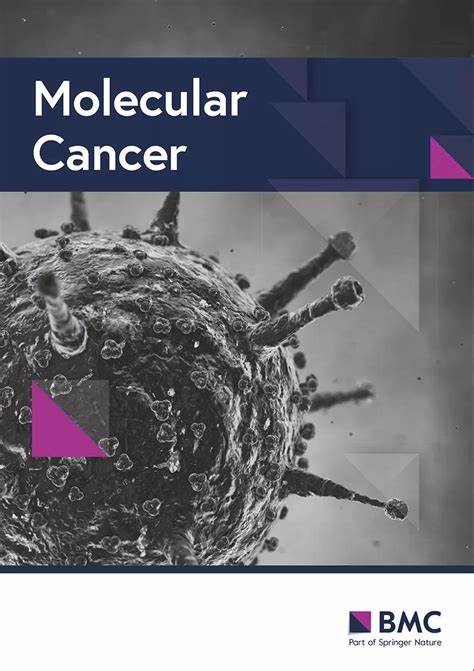绘制癌症结直肠代谢生物地理图:挑战右侧与左侧分类法
IF 27.7
1区 医学
Q1 BIOCHEMISTRY & MOLECULAR BIOLOGY
引用次数: 0
摘要
大肠癌(CRC)通常分为右侧癌、左侧癌和直肠癌。临床病理、分子特征和风险因素在结直肠内不会发生突变,即使在细化的亚位点内也存在差异,这可能导致临床相关的 CRC 生物标志物的鉴定不一致。我们绘制了一张 CRC 代谢组图谱,以描述结直肠不同亚位点癌症的代谢物、诊断和生存异质性之间的关联。我们利用 372 例患者匹配的肿瘤和正常粘膜组织,采用液相色谱-质谱法研究了结直肠七个亚部位的代谢组图谱:盲肠(63 例)、升结肠(44 例)、横结肠(32 例)、降结肠(28 例)、乙状结肠(75 例)、直乙状结肠(38 例)和直肠(92 例)。肿瘤和正常粘膜中分别有 39 种和 70 种代谢物(包括胆汁酸、溶血磷脂酰胆碱和溶血磷脂酰乙醇胺)发生明显改变,这表明 CRC 亚位点之间存在位点间代谢异质性。从盲肠到直肠,代谢物丰度呈明显的线性渐变趋势:23 种肿瘤特异性代谢物、30 种正常粘膜特异性代谢物以及 15 种肿瘤和正常粘膜代谢物在整个结直肠中的浓度梯度与疾病状态有关。呈现线性趋势的代谢物包括胆汁酸、氨基酸、溶血磷脂酰胆碱和溶血磷脂酰乙醇胺。将肿瘤与患者匹配的正常粘膜进行比较,发现了每个亚部位特有的代谢物变化,从而进一步凸显了结直肠 7 个亚部位癌症代谢的差异。此外,与生存相关的代谢物也各不相同,而且是每个亚位点独有的。最后,我们设计了一个交互式和可公开访问的 CRC 代谢组数据库,以便访问和利用这一丰富的数据资源 ( https://colorectal-cancer-metabolome.com/yale-university )。从盲肠到直肠,代谢物丰度逐渐发生变化。患者存活率和不同代谢物与结直肠解剖亚部位之间的关联揭示了结直肠癌之间的差异。这些亚部位间的代谢异质性丰富了目前的认识,并证实了以前的研究对右侧癌、左侧癌和直肠癌传统分类的挑战,这些研究通过确定特定的代谢物,对 CRC 亚部位异质性提供了新的生物学见解。这项研究中设计的数据库将使研究人员能够深入研究有关 CRC 代谢组的细粒度信息,而这些信息到目前为止还无法获得。本文章由计算机程序翻译,如有差异,请以英文原文为准。
Charting the metabolic biogeography of the colorectum in cancer: challenging the right sided versus left sided classification
Colorectal cancer (CRC) is conventionally classified as right sided, left sided, and rectal cancer. Clinicopathological, molecular features and risk factors do not change abruptly along the colorectum, and variations exist even within the refined subsites, which may contribute to inconsistencies in the identification of clinically relevant CRC biomarkers. We generated a CRC metabolome map to describe the association between metabolites, diagnostic and survival heterogeneity in cancers of different subsites of the colorectum. Utilizing 372 patient-matched tumor and normal mucosa tissues, liquid chromatography-mass spectrometry was applied to examine metabolomic profiles along seven subsites of the colorectum: cecum (n = 63), ascending colon (n = 44), transverse colon (n = 32), descending colon (n = 28), sigmoid colon (n = 75), rectosigmoid colon (n = 38), and rectum (n = 92). 39 and 70 significantly altered metabolites (including bile acids, lysophosphatidylcholines and lysophosphatidylethanolamines) among tumors and normal mucosa, respectively, showed inter-subsite metabolic heterogeneity between CRC subsites. Gradual changes in metabolite abundances with significantly linear trends from cecum to rectum were observed: 23 tumor-specific metabolites, 30 normal mucosa-specific metabolites, and 15 metabolites in both tumor and normal mucosa, had concentration gradients across the colorectum, and is disease status dependent. The metabolites that showed a linear trend included bile acids, amino acids, lysophosphatidylcholines, and lysophosphatidylethanolamines. Comparison of tumors to patient-matched normal mucosa revealed metabolite changes exclusive to each subsite, thereby further highlighting differences in cancer metabolism across the 7 subsites of the colorectum. Furthermore, metabolites associated with survival were different and unique to each subsite. Finally, an interactive and publicly accessible CRC metabolome database was designed to enable access and utilization of this rich data resource ( https://colorectal-cancer-metabolome.com/yale-university ). Gradual changes exist in metabolite abundances from the cecum to the rectum. The association between patient survival and distinct metabolites with anatomic subsite of the colorectum, reveals differences between cancers across the colorectum. These inter-subsite metabolic heterogeneities enrich the current understanding and substantiate previous studies that have challenged the conventional classification of right-sided, left-sided, and rectal cancers, by identifying specific metabolites that offer new biological insights into CRC subsite heterogeneity. The database designed in this study will enable researchers to delve into granular information on the CRC metabolome, which until now has not been available.
求助全文
通过发布文献求助,成功后即可免费获取论文全文。
去求助
来源期刊

Molecular Cancer
医学-生化与分子生物学
CiteScore
54.90
自引率
2.70%
发文量
224
审稿时长
2 months
期刊介绍:
Molecular Cancer is a platform that encourages the exchange of ideas and discoveries in the field of cancer research, particularly focusing on the molecular aspects. Our goal is to facilitate discussions and provide insights into various areas of cancer and related biomedical science. We welcome articles from basic, translational, and clinical research that contribute to the advancement of understanding, prevention, diagnosis, and treatment of cancer.
The scope of topics covered in Molecular Cancer is diverse and inclusive. These include, but are not limited to, cell and tumor biology, angiogenesis, utilizing animal models, understanding metastasis, exploring cancer antigens and the immune response, investigating cellular signaling and molecular biology, examining epidemiology, genetic and molecular profiling of cancer, identifying molecular targets, studying cancer stem cells, exploring DNA damage and repair mechanisms, analyzing cell cycle regulation, investigating apoptosis, exploring molecular virology, and evaluating vaccine and antibody-based cancer therapies.
Molecular Cancer serves as an important platform for sharing exciting discoveries in cancer-related research. It offers an unparalleled opportunity to communicate information to both specialists and the general public. The online presence of Molecular Cancer enables immediate publication of accepted articles and facilitates the presentation of large datasets and supplementary information. This ensures that new research is efficiently and rapidly disseminated to the scientific community.
 求助内容:
求助内容: 应助结果提醒方式:
应助结果提醒方式:


